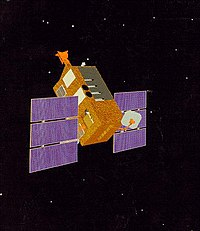
Photo from wikipedia
Purpose Spatial resolution (SR) and counting efficiency (CE) are two pivotal parameters for Nuclear Medicine devices based on scintillation crystals. These parameters are in conflict with one another: the smaller… Click to show full abstract
Purpose Spatial resolution (SR) and counting efficiency (CE) are two pivotal parameters for Nuclear Medicine devices based on scintillation crystals. These parameters are in conflict with one another: the smaller the thickness of the scintillation crystal, the better (the worse) the resolution (the efficiency). In this work, a phoswich approach is reported, allowing devices to provide information optimized for both parameters. Methods In [1] , [2] a parameter to solve the Depth-of-Interaction (DoI) in scintillation detectors has been presented. As proved in [3] , it allows to distinguish the layer of a two-layers phoswich in which gamma-photons interact with the detector, too. The experimental response of a 50 × 50 mm2, 20 mm-thick, LYSO detector has been compared with a simulated detector of the same area based on two 10 mm-thick layers, coupled through optical grease (see Figure). Results The 20 mm-thick experimental detector exhibits a SR ranging from 2.85 (upper 10 mm) to 2.51 (lower 10 mm). With the proposed phoswich approach, the resolution improves up to 2.32 mm for the upper layer (again, 10 mm-thick) and 1.50 mm for the lower layer. With this approach, one can basically choose between the configuration showed in Table. Anyway, the phoswich approach improves the overall SR. Conclusions The proposed method, applied to phoswich detectors, allows to arbitrarily improve either CE or SR. The first is enhanced by selecting events from both layers, whereas the latter improves by selecting events from the lower layer.
Journal Title: Physica Medica
Year Published: 2018
Link to full text (if available)
Share on Social Media: Sign Up to like & get
recommendations!